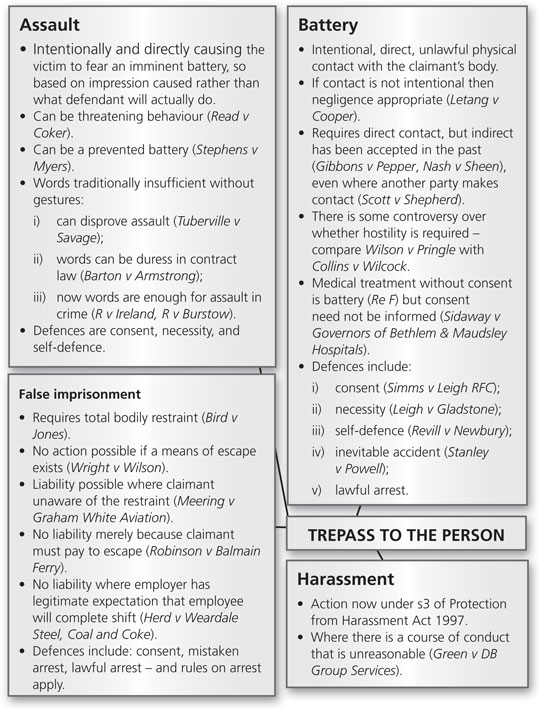Trespass to the person

Trespass to the Person

8.1.1 Definitions
1. The old view was that assault was an incomplete battery.
2. Modern definition is intentionally and directly causing a person to fear being victim of an imminent battery (Letang v Cooper (1965)).
8.1.2 Ingredients of the Tort
1. Assault is free-standing, so intention refers to the impression it will produce in claimant, not as to what defendant intends to do. Compare R v St. George (1840) with Blake v Barnard (1840).
2. No harm or contact is required (I de S et Ux v W de S (1348)).
3. Requires active behaviour, so merely barring entry is no assault (Innes v Wylie (1844)).
4. However, threatening behaviour can be assault (Read v Coker (1853)).
5. An attempt to commit a battery which is thwarted is still an assault (Stephens v Myers (1830)).
6. Traditionally words alone were not an assault:
 but could disprove an assault (Tuberville v Savage (1669));
but could disprove an assault (Tuberville v Savage (1669));
 and a threat on its own can be assault (Read v Coker);
and a threat on its own can be assault (Read v Coker);
 and in contract law, words can amount to duress if the threat is sufficiently serious (Barton v Armstrong (1969));
and in contract law, words can amount to duress if the threat is sufficiently serious (Barton v Armstrong (1969));
 more recently, in crime, words alone and even silence have been accepted as assault (R v Ireland; R v Burstow (1998)).
more recently, in crime, words alone and even silence have been accepted as assault (R v Ireland; R v Burstow (1998)).
7. The claimant must be fearful of an impending battery. Compare Smith v Superintendent of Woking (1983) with R v Martin (1881).
8.1.3 Defences
1. Consent (as in sports).
2. Self-defence (e.g. threatening an attacker).
3. Necessity (frightening people away from possible harm).
8.2.1 Definitions
There are a number of possible definitions:
 the defendant intentionally and directly applies unlawful force to claimant’s body – but force is irrelevant in, for example, medicine;
the defendant intentionally and directly applies unlawful force to claimant’s body – but force is irrelevant in, for example, medicine;
 the defendant, intending the result, does an act which directly and physically affects the claimant, but still implies damage;
the defendant, intending the result, does an act which directly and physically affects the claimant, but still implies damage;
 has been said to include the ‘ordinary collisions of life’, but this is very unlikely (Wilson v Pringle (1987)).
has been said to include the ‘ordinary collisions of life’, but this is very unlikely (Wilson v Pringle (1987)).
8.2.2 Ingredients of the Tort
1. Intention is a fairly recent requirement – without it an action should be brought in negligence (Fowler v Lanning (1959)).
2. Traditional distinction was between direct and indirect contact:
 but now between intention and negligence (Letang v Cooper (1965));
but now between intention and negligence (Letang v Cooper (1965));
 although in traditional cases indirect damage was often accepted (Gibbons v Pepper (1695));
although in traditional cases indirect damage was often accepted (Gibbons v Pepper (1695));
 often where negligence might have seemed more appropriate (Nash v Sheen (1953));
often where negligence might have seemed more appropriate (Nash v Sheen (1953));
 and even where other parties have actually caused the harm (Scott v Shepherd (1773)).
and even where other parties have actually caused the harm (Scott v Shepherd (1773)).
3. Usually no liability for omissions in trespass, only positive acts (Fagan v Metropolitan Police Commissioner(1969)).
4. Hostility is a recent requirement, with traditional foundations:
 Lord Holt CJ in Cole v Turner (1704) suggested that ‘the least touching of another in anger is a battery …’;
Lord Holt CJ in Cole v Turner (1704) suggested that ‘the least touching of another in anger is a battery …’;
 restated in Wilson v Pringle (1987);
restated in Wilson v Pringle (1987);
 but conflicting with Lord Goff’s test in Collins v Wilcock (1987) of whether the contact is acceptable in the conduct of daily life.
but conflicting with Lord Goff’s test in Collins v Wilcock (1987) of whether the contact is acceptable in the conduct of daily life.
5. Medical treatment without consent has always been battery: